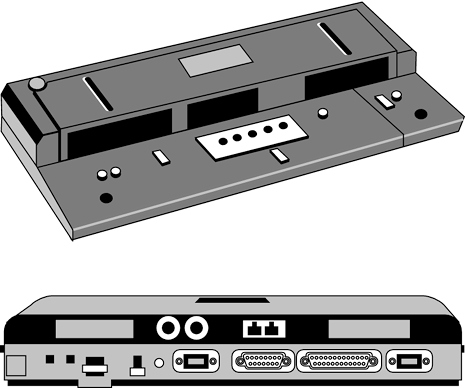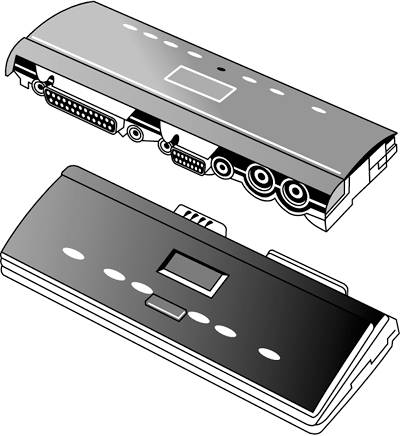Port Replicators
| As stated earlier, many users do not need the extensive range of capabilities provided by a full-featured docking station. Nor do they want to pay for it. Instead, they need merely a network adapter and a simple way to connect and disconnect a collection of notebook peripherals. The port replicator is designed to do just that (see Figure 14.5). Figure 14.5. The Toshiba Advanced Port Replicator II, showing both front and back views. The port replicator shown here has an extensive array of connectors, including two PS/2 connectors (for a keyboard and mouse), one RJ-11 phone-line connector, one RJ-45 network connector, two USB ports, two video connectors (standard RGB and DVI [Digital Video Interface]), and IEEE 1394 (FireWire), parallel, and serial connectors. As its name suggests, the main function of a port replicator is to duplicate the connectors already available on the back panel of a notebook computer. In most cases, the port replicator also provides additional connectors that were left off the notebook either to save weight, lower costs, or reserve room for another component. These additional connectors may include a network adapter, extra USB connectors, and various video and sound connectors. In a typical configuration, a port replicator may have an AC adapter, a mouse, a printer, a LAN cable, and a phone line connected to it. To connect to these five different devices, all a notebook user has to do is snap the notebook into the port replicator, thus saving considerable time. Conversely, before going out on the road, all the user needs to do is push a button or a lever to undock the notebook from the port replicator. The actual connection process is more complicated than it sounds. The port replicator usually has two or three plastic pins that mate with corresponding holes on the notebook. These pins ensure that the port replicator's large connection plug will line up exactly with the socket on the notebook. This connector has dozens of pins or lines and is capable of handling all the signals involved with all the connectors on the port replicator. Once the notebook has been fully inserted into the port replicator, a ratchet usually engages to hold the notebook in place, causing the characteristic snapping sound. Many port replicators include a network interface. At one time this was an important feature for port replicators, often being the primary justification for purchasing one of these devices. Now, however, with most notebook computers coming standard with either a wired or wireless LAN interface, the importance of having a LAN interface in the port replicator has declined. Proprietary Port ReplicatorsAs is the case with docking stations , port replicators are highly proprietary items designed for use with only certain notebooks from a single manufacturer. Some manufacturers have done a fairly good job of ensuring that future notebook models will be compatible with previous port replicators. Unfortunately, despite the popularity of port replicators, no standard connector for these devices has ever arisen. Notebook manufacturers are very much conscious of the fact that once you own a port replicator from XYZ Company, you are more likely to protect your investment by making sure your next notebook purchase will have an XYZ label on it. If instead you later switch to another notebook manufacturer, your old port replicator becomes useless. Because proprietary port replicators are not subject to competition, their prices may be relatively expensive. Generic or third-party port replicators, however, may enable users to save money while not locking them into a particular notebook manufacturer. Third-Party Port ReplicatorsBecause port replicators offer less functionality than docking stations, it is easier for third-party manufacturers to design generic versions of these devices. Indeed, some notebook manufacturers, such as Dell, actively promote the sale of these devices on their Web sites as accessories for their notebooks. As is the case for docks, generic port replicators eschew the proprietary docking station connector on the back or the bottom of the notebook and instead use the notebook's standard high-bandwidth interfaces, such as a CardBus PC Card slot or a USB connector. Two companies are prominent in this area: Mobility Electronics and Targus. Both offer generic port replicators that connect to the notebook via the USB port. Note, however, that these port replicators usually cannot power the notebook. Therefore, in most docking situations, users will have to connect their notebooks to both the generic port replicator and their notebook's AC power supply. An example of a generic port replicator is the Targus USB Mobile Expansion Hub, shown in Figure 14.6 with top and rear views. This $100 simple port replicator connects to notebooks via a USB cable and provides a self- powered standalone USB hub with two USB ports, a serial port, a parallel printer port, and two PS/2 ports (for mouse and keyboard). Figure 14.6. The Targus USB Mobile Expansion Hub, shown here in top and rear views, is an example of a third-party port replicator. |
EAN: 2147483647
Pages: 182

